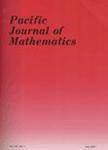版权所有:内蒙古大学图书馆 技术提供:维普资讯• 智图
内蒙古自治区呼和浩特市赛罕区大学西街235号 邮编: 010021

作者机构:Univ Buenos Aires FCEyN Dept Matemat Ciudad UnivPabellon 1 RA-1428 Buenos Aires DF Argentina
出 版 物:《PACIFIC JOURNAL OF MATHEMATICS》 (Pac. J. Math.)
年 卷 期:2017年第287卷第2期
页 面:257-295页
核心收录:
学科分类:07[理学] 0701[理学-数学] 070101[理学-基础数学]
主 题:Dirichlet boundary conditions dynamic programming principle p-Laplacian tug-of-war games
摘 要:We prove existence and uniqueness of viscosity solutions for the problem max {-Delta(p1)u(x), -Delta(p2)u(x)} = f(x) in a bounded smooth domain Omega subset of R-N with u = g on partial derivative Omega. Here -Delta(p)u = (N + p)(-1) vertical bar Du vertical bar(2-p) div (vertical bar Du vertical bar(p-2)Du) is the 1-homogeneous p-Laplacian and we assume that 2 = p(1), p(2) = infinity. This equation appears naturally when one considers a tug-of-war game in which one of the players (the one who seeks to maximize the payoff) can choose at every step which are the parameters of the game that regulate the probability of playing a usual tug-of-war game (without noise) or playing at random. Moreover, the operator max {-Delta(p1)u(x), -Delta(p2)u(x)} provides a natural analogue with respect to p-Laplacians to the Pucci maximal operator for uniformly elliptic operators. We provide two different proofs of existence and uniqueness for this problem. The first one is based in pure PDE methods (in the framework of viscosity solutions) while the second one is more connected to probability and uses game theory.